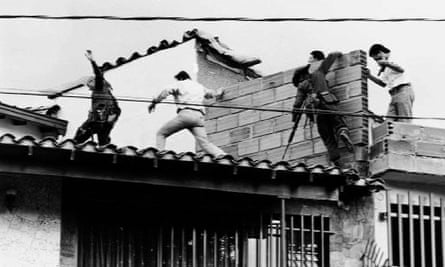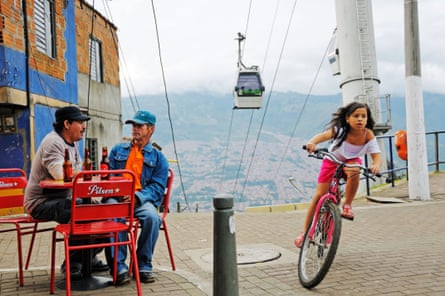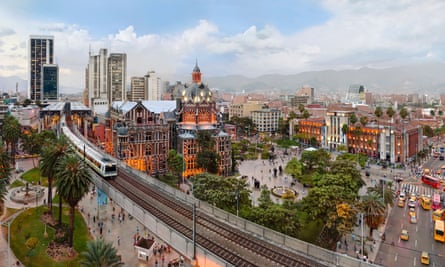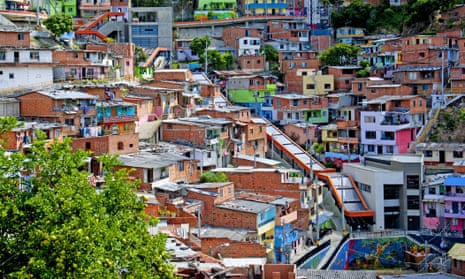“I’d never been to that neighbourhood before. It was a new world to me.” The architect Luis Miguel Velez Wiesner is recalling the first time he set foot in Santo Domingo, one of Colombia’s most notorious comunas (slums), when the Medellín cable car opened in 2004. “The first time, I felt like I was going to be kidnapped. Now it’s quite different – there are lots of places to eat and shop. It feels safe now.”
For intrepid residents such as Wiesner, stepping off the cable car to enter the once out of bounds “other side” of Medellín, was a seminal moment in the history of their city.
Their photos in front of Giancarlo Mazzanti’s dramatic new España library in Santo Domingo sent an altogether different image of Medellín to the world. The long-entrenched division between the gridded city in the valley and the informal settlements on the hills was finally disappearing. The world’s most dangerous city had become accessible, and safe.
“I always lived in a gated compound,” Wiesner says. “When we were young, my mother was afraid when we had to leave the house. We were in a shopping mall once when a bomb exploded. It was quite normal. It’s really different now though – they’re not shooting everyone, everywhere.”
Medellín’s revival is a story of dynamic interplays between key figures on either side of the divide – not least mayors Luis Perez, Sergio Fajardo and Alonso Salazar, and the drug lords Pablo Escobar and Don Berna – and of radical experiments in urban planning and participatory forms of governance.

No account of Medellín can be written without considering Escobar’s role in masterminding and controlling the city’s fortunes. It might seem a little unorthodox to consider one of the world’s most powerful and violent criminals an urban planner, but to ignore his role in the story of Medellín’s development would be to grossly distort history.
Escobar and his cartels helped set the conditions for urban change to happen. They led Medellín to the brink of disaster, then demanded it change. In 1982, Escobar launched his “Medellín Without Slums” programme – a politically motivated but nonetheless heartfelt campaign to rid the city of its slums and provide a “life of noble dignity” for the urban poor who, in Escobar’s words, had been living in an “inferno of garbage”.
Besides increasing his popularity, power and even election-winning potential – Escobar was elected to Colombia’s house of representatives for a brief period in 1982, before his associations with drug trafficking had him expelled – Medellín Without Slums was the first effort to make change for the poor from within. Through it, Escobar – who was eventually shot and killed by security forces in December 1993 – gave the city’s comunas a political voice and a vehicle through which to demand change.
He radicalised, politicised and militarised the poor, turning them against the citizens of the formal city in all-out civil war. Escobar’s legacy, in planning terms, was this transformation of the spatial divide between formal and informal territories, between rich and poor, into a violent opposition of territories.

At one point, Medellín was the most dangerous city on earth. From 1990 to 1993, more than 6,000 people were murdered annually, and not just in the slums. Drive-by shooting was regular and indiscriminate. The accounts of suffering and violence are truly obscene – not simply of warfare between gang lords and drug criminals, but of children being tortured and mutilated for accidentally crossing an invisible territorial boundary, of growing up with homicides taking place in their bedrooms, of bullets flying through their curtains at dinner.
The need for change was urgent – and perhaps only such extreme conditions could have led to such radical urban experimentation. According to Colombian architect and UCL lecturer Catalina Ortiz, who worked on Medellín’s strategic city plans of 2005 and 2013 under Mayor Fajardo, the critical moment came a quarter of a century ago.
“For me, 1991 was a key turning point for the whole country. It was the worst and the best moment – a time of complete crisis and a moment of hope,” Ortiz says. “It was truly a moment where everyone felt it could not get any worse – we had to do something.”
The country’s new constitution, ratified that year, gave greater independence to local governments to elect their own leaders, offering more control over urban development to local people with local knowledge and expertise. It was also the moment when the national government, with international support from the United Nations, started to intervene in Medellín, dismantling and demobilising guerrilla paramilitary groups.
“The interest of the national government was an acknowledgement that the situation was out of control,” Ortiz explains. “They recognised that governance in Medellín had been lost.”
But this was also a key moment for urban planning – the point at which the city’s issues were considered a matter of urban design. “The government recognised that Medellín’s security issues could not be dealt with through policy measures alone. It was the point at which the governing entities started to recognise and address the urban context of the problem,” Ortiz says.

Medellín’s authorities started a series of radical programmes to reorganise the social fabric of the comunas and mobilise the poor. The city’s planners began addressing its endemic violence and inequity through the design of public spaces, transit infrastructure and urban interventions into the slums.
Key to their approach was a commitment to the public realm as a truly shared space, and a faith that they could transform Medellín’s public spaces from sites of segregation and warfare into spaces where communities would come together.
But Medellín’s social urbanism stretches way beyond the more modest experiments with participatory planning and community consultation that are now vogue in cities across the globe. The sheer enormity and complexity of the issues here demanded something unique – an urbanism of inclusion, where the dispossessed became partners in driving urban change.
Influenced by European regeneration models, notably in Barcelona, Medellín’s 1995 and 1999 strategic plans set a new agenda for the city. “They redefined the realm of what ‘public work’ is. Participatory planning became a key question of social equity,” Ortiz explains.
In 1998, it became constitutional law in Colombia that every municipality had to develop a masterplan, and that planning could not happen without social participation.
Into this situation parachuted mayor Fajardo and the architect Alejandro Echeverri. Fajardo surrounded himself by a team of experts and specialists at his Urban Development Corporation (EDU), working with architects, planners, engineers and sociologists to collectively manage Medellín’s change. On many projects, the design team worked with a “man on the ground” – a community representative who was mouthpiece and interpreter for the community in which interventions were being proposed.

Echeverri says this level of collaboration and integration of professions and disciplines was fundamental to the success of Medellín’s projects – which meant also having to “call on the bad guys” to help. He explains: “Often the person we needed to deliver the plan was one of the bad guys, part of the problem.”
In a context as divided and oppositional as this, where the establishment was hated and figures of authority treated with distrust, the gulf between the rich and the poor, the authority and the individual, had to be bridged through joint decision-making and co-design.
Unlike previous political figures, Fajardo was often present at community meetings in the comunas. His team held “imagination workshops” in which comuna dwellers were given the opportunity to imagine alternatives; to redesign where they lived. The EDU achieved a truly integrated form of participatory planning, establishing a common ground between once warring factions and a common will to make change.
The projects were seen as chains of interventions that stitched the city together. Integrated mobility systems consisting of elevated metros, cable cars, bridges and escalators were planned to keep the city moving and link previously disconnected neighbourhoods. These were accompanied by socially minded, architectural-scale interventions in the poorest areas: libraries, community buildings and cultural centres – places for people to come together, interact and learn.
Fajardo invested in Medellín’s civic centre as well as the slums; a two-pronged approach that legitimated the previously neglected comunas by treating them as equal parts of the whole city.
Architecturally, one of Echeverri’s major successes was striking a balance between the embedded and the iconic – integrating spaces, places and systems into the social fabric of the city on the one hand, while also creating buildings of international quality which would be photographed again and again.

But as well as sending a new image of the city to the world, changing its reputation and attracting a tourist economy, there is a more subtle design intelligence at play here. Watching people slide up and down the brightly coloured escalators in Comuna 13 (still believed to be one of Medellín’s most dangerous comunas), with their decorative metal canopies, air-conditioning and soft music, set against the haphazard irregularity of the slum, is a collision of worlds. And perhaps this is key to the success of the projects: bringing two alien worlds together and forcing them to interact, adjust to one another, and forge a new identity.
Fajardo was something of a political anomaly. A maths professor with no previous background in politics, he managed to overcome the traditional political parties, all rife with corruption, to become mayor in 2003 with no tarnish.
He used this autonomy well, entering political and spatial territories that were previously out of bounds. His independence enabled people to accept him and get to know him – the new mayor from nowhere who walked in the city’s slums. Many explain Medellín’s relative stability between 2003 and 2009 as thanks to an accord between the city’s two independent leaders, Fajardo and drug lord Don Berna – both of whom commanded peace and calm from different sides of Medellín’s divide.
In establishing the EDU, Fajardo instigated a bureaucratic independence – free of Medellín’s corrupt and inefficient ways – that was key to the city’s successes. This independence allowed the EDU to look freely at the city as a whole, enabling its experimental and visionary approach that exceeded what previous authorities had achieved. In this, it is a lesson to cities around the world of the importance of independent design bureaus working alongside local authorities.
Another crucial form of independence concerns autonomy of funding, in the form of the public utilities company EPM. A unique institution, the EPM is owned by the city municipality, and is a wealthy institution that exports energy to the rest of Colombia and other parts of South America too. The 1991 constitution decided that the EPM would contribute 30% of its profit to the city for municipal use – a crucial source of funding that subsequent mayors have been able to use to power their urban interventions.
“Several entities were crucial for physical change in Medellín,” Ortiz says. “The centralised agencies of the state, with their strategic city plans, and the semi-autonomous entities like the EDU and EPM, who had less accountability.”
But also key to Medellín’s transformation was an attitude towards urbanism as a tool for promoting social mobility and equity – a process in which comuna dwellers became clients, participants and stakeholders in the city, with the chance to design their own destiny.
This approach succeeded in crossing boundaries where political policy, social strategy, policing and corruption had previously failed. The city transformed itself by allowing the people to stitch it back together themselves.
Alex Warnock-Smith is founding director of Urban Projects Bureau, and course master of the Architectural Association Graduate School’s Housing & Urbanism programme.
Does your city have a little-known story that made a major impact on its development? Please share it in the comments below or on Twitter using #storyofcities

Comments (…)
Sign in or create your Guardian account to join the discussion